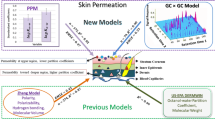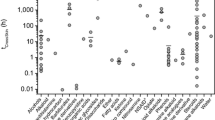Abstract
A new method for estimating dermal absorption including the effects of exposure time and chemistry is described generally in Part 1 of this series. This method accounts for the larger absorption rates during the initial exposure period as well as the hydrophilic barrier which the viable epidermis presents to lipophilic chemicals. A key parameter in this procedure, the ratio of the stratum corneum and epidermis permeabilities (B) depends on molecular weight and octanol-water partitioning. Several approaches for approximating B and its affect on the dermal absorption prediction are discussed here. Generally, the parameter B is only important for highly lipophilic chemicals which also have relatively small molecular weights. When B is important, the recommended prediction for B is based on the Potts and Guy correlation for human stratum corneum permeability.
Similar content being viewed by others
REFERENCES
R. L. Cleek and A. L. Bunge. A new method for estimating dermal absorption from chemical exposure. 1. General approach. Pharm. Res., 10:497–506 (1993).
J. A. Barrie, J. D. Levine, A. S. Michaels, and P. Wong. Diffusion and solution of gases in composite rubber membranes. Trans. Faraday Soc. 59:869–878 (1963).
R. A. Siegel. Algebraic, differential, and integral relations for membranes in series and other multilaminar media: Permeabilities, solute consumption, lag times, and mean first passage times. J. Phys. Chem. 95:2556–2565 (1991).
R. O. Potts and R. H. Guy. Predicting skin permeability. Pharm. Res. 9:663–669 (1992).
R. J. Scheuplein. Molecular structure and diffusional processes across intact skin. Final report to the US Army Chemical R&D Laboratories, Edgewood Arsenal, Maryland, Contract DA 18-108-AMC-726(A) (1967).
R. J. Scheuplein, I. H. Blank, G. J. Brauner, and D. J. MacFarlane. Percutaneous absorption of steroids. J. Invest. Dermatol. 52:63–70 (1969).
M. S. Roberts, R. A. Anderson, D. E. Moore, and J. Swarbick. The distribution of nonelectrolytes between human stratum corneum and water. Aust. J. Pharm. Sci. 6:77–82 (1977).
R. J. Scheuplein and I. H. Blank. Permeability of the skin. Physiol. Reviews, 51:702–747 (1971).
K. Tojo and A. R. C. Lee. Penetration and bioconversion of drugs in the skin. J. Chem. Engr. Japan, 24:297–301 (1991).
R. H. Guy and J. Hadgraft. The prediction of plasma levels of drugs following transdermal application. J. Cont. Rel. 1:177–182 (1985).
R. H. Guy and J. Hadgraft. Pharmacokinetic interpretation of the plasma levels of clonidine following transdermal deliver. J. Pharm. Sci. 74:1016–1018 (1985).
J. Hadgraft. Absorption of materials by or through the living skin. Intl. J. Cosmetic Sci. 7:103–115 (1985).
W. R. Lieb and W. D. Stein. Biological membrane behave as non-porous polymer sheets with respect to diffusion of non-electrolytes. Nature 224:240–243 (1967).
J. M. Diamond and Y. Katz. Interpretation of nonelectrolyte partition coefficients between dimyristoyl lecithin and water. J. Memb. Biol. 17:127–154 (1974).
G. L. Flynn. Physicochemical determinants of skin absorption. In: Principles of Route-to-Route Extrapolation for Risk Assessment, Eds. T. R. Gerrity and C. J. Henry, pp. 93–127, Elsevier, New York (1990).
R. H. Guy, J. Hadgraft, H. I. Maibach. Percutaneous absorption in Man: A kinetic approach. Toxicol. Appl. Pharmacol. 78:123–129 (1985).
M. H. Cohen and D. Turnbull. Molecular transport in liquids and gases. J. Chem. Phys. 31:1164–1169 (1959).
W. R. Lieb and W. D. Stein. Implications of two different types of diffusion for biological membranes. Nature 234:219–222 (1971).
W. R. Lieb and W. D. Stein. Non-Stokesian nature of transverse diffusion within human red cell membranes. J. Memb. Biol. 92:111–119 (1986).
G. B. Kasting, R. L. Smith, and E. R. Cooper. Effect of lipid solubility and molecular size on percutaneous absorption. In: Pharmacokinetics. Eds. B. Shroot and H. Schaefer, pp. 138–153. Karger, Basel (1987).
E. L. Cussler. Diffusion. Mass Transfer in Fluid Systems. Cambridge University Press, New York (1984).
R. O. Potts and M. L. Francoeur. Lipid biophysics of water loss through the skin. Proc. Natl. Acad. Sci. 87:3871–3873 (1990).
R. O. Potts, and M. L. Francoeur. The influence of stratum corneum morphology on water permeability. J. Invest. Dermatol. 96:495–499 (1991).
Author information
Authors and Affiliations
Rights and permissions
About this article
Cite this article
Bunge, A.L., Cleek, R.L. A New Method for Estimating Dermal Absorption from Chemical Exposure: 2. Effect of Molecular Weight and Octanol-Water Partitioning. Pharm Res 12, 88–95 (1995). https://doi.org/10.1023/A:1016242821610
Issue Date:
DOI: https://doi.org/10.1023/A:1016242821610




